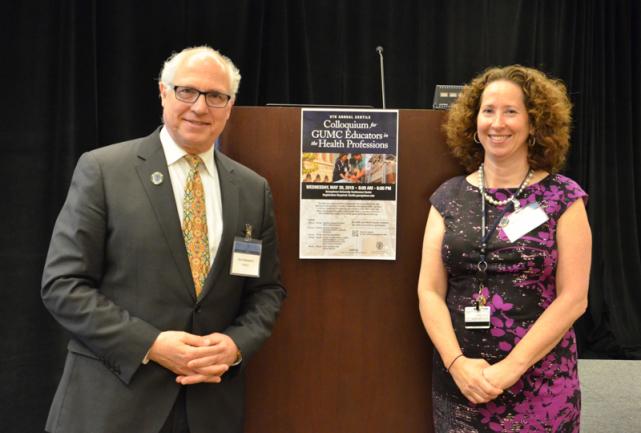CENTILE Colloquium Brings Together Educators from Across the Medical Center

Posted in GUMC Stories | Tagged CENTILE, School of Medicine
(June 3, 2018) — About 80 attendees participated in the Fifth Annual Colloquium for GUMC Educators in the Health Professions, organized by the Center for Innovation and Leadership in Education (CENTILE), which included a workshop, oral sessions, posters and a plenary on trends in health professions education. The colloquium planning committee was led by Pamela Saunders, PhD, CENTILE programs chair.
“Through the School of Nursing & Health Studies, our biomedical graduate education programs and the School of Medicine, often in collaboration with our health system partner MedStar, we have both the privilege and really, the awesome responsibility of shaping tomorrow’s health care leaders,” said Edward B. Healton, MD, MPH, executive vice president for health sciences and executive dean of the School of Medicine at Georgetown University Medical Center, at the May 30 event at Georgetown University Hotel and Conference Center.
“Now more than ever, our work as educators is even more important and your presence here really signals all of your commitment to that work,” Healton added. “We’re certainly here to help with any of those things and to be part of the future, so thank you very much for gathering all together.”
Recognizing the GUMC Teaching Academy
Since its establishment five years ago, CENTILE has driven innovation, excellence and scholarship in education at GUMC. “We have a number of goals — to build a community of educators, of which you are one; to provide faculty with opportunities for skills training; and thirdly, to develop mechanisms for peer recognition,” said Aviad Haramati, PhD, director of CENTILE.
One of those mechanisms for peer recognition, the GUMC Teaching Academy for the Health Sciences, was established by CENTILE in January 2015. Early career Teaching Academy members can progress from the protege level to associate, then principal educator by developing expertise in one of the five domains — direct teaching, advising and mentoring, instructional design, educational leadership and educational scholarship. A distinguished educator, the highest level of membership in the Teaching Academy, is recognized for outstanding achievement in three of the five domains.
“We currently stand at 105 members of the Teaching Academy — 43 from MedStar Health and the various hospitals and 62 from GUMC, and these are broken up into 23 in the protege category, 47 in associate, 32 have attained principal status in one of five domains, and three have reached distinguished educator status,” Haramati said.
Alison Whelan, MD, chief medical education officer at the Association of American Medical Colleges (AAMC), praised the Teaching Academy for recognizing faculty members from both GUMC and MedStar Health. “It’s really remarkable that it is a health system–CENTILE school connection, because we can’t do anything without each other,” she said. “And so I just wanted to applaud you for that, having looked at many different academies, I think you’ve really created a spot that speaks to what it is you’re trying to do.”
Shifting to Competency-Based Medical Education
In her role at AAMC, Whelan works with educators across the country to help prepare the next generation of medical professionals. The move towards competency-based education enables direct observation and entrustment of learners as they progress through training. “The question I think that we all are struggling with is, medicine is changing so rapidly, the health care dynamics are changing so rapidly, and actually education, what we know about how to teach adult learners to be lifelong learners, is changing rapidly,” she said. “What can we be doing to really improve it and how can we really respond to all of these pressures?”
While there are several different frameworks for medical education, they don’t exist in opposition to each other, Whelan said. “It’s just different ways of looking at the same question — are you ready to do this?” she said. “And if you’re not, what are the pieces of this that you need to change to move forward?”
Whelan also mentioned the importance of integrating the arts and humanities into medical education — something that AAMC plans to promote in the near future. “I feel like I’m speaking to the choir here, but there is a really important role of the humanities and art, we believe, in medical education,” she said. “It’s integrative, it’s there, it’s lots of different places, it’s been used for diversity, it’s been used for cultural competency, it’s been used for wellness, it’s been used for a whole lot of different areas. And so what we’re trying to do is figure out how we can best sort out, are there some core aspects of this, some most promising practices, that are not just for the undergraduates but for the health professions across the continuum.”
Kat Zambon
GUMC Communications
